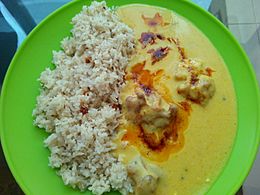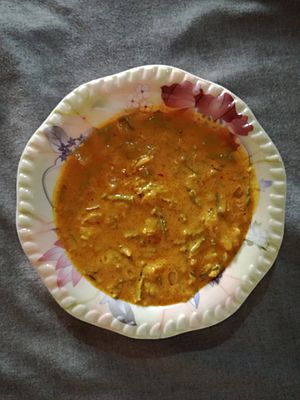Kadhi facts for kids

Kadhi Chawal (Kadhi served with boiled rice) from India
|
|
| Place of origin | India |
|---|---|
| Region or state | Rajasthan |
| Associated national cuisine | Indian |
| Main ingredients | Dahi (yogurt), gram flour, vegetables, water |
Kadhi or karhi is a dish originating from Rajasthan, India. It consists of a thick gravy based on gram flour, and contains vegetable fritters called pakoras, to which dahi (yogurt) is added to give it a bit of sour taste. It is often eaten with cooked rice or roti.

India
In Northern India, pakoras are added to the gram flour gravy and sour yogurt is added to add flavor to it. They are eaten either with boiled rice or roti. In Gujarat and Rajasthan, it is usually served with khichdi, roti, paratha or rice. It is considered a light food. Gujarati and Rajasthani kadhi differs from the Uttar Pradesh variety. Traditionally, it is a little sweeter than the other variants, because sugar or jaggery is added to it, but it can be made without sugar for a more sour taste. It is eaten without pakoras and its consistency is slightly thinner. The Gujarati kadhi is made ideally from buttermilk, as this gives it a smoother texture compared to yogurt. Variations of this basic dish include the addition of certain vegetables, notably bhindi (okra) in which case it is known as bhinda ni kadhi. In Punjab, kadhi is a simple, quick winter meal. Made from besan (Gram flour) to thicken the consistency, and adding pakoras, it is eaten with either long-grain basmati rice or, more commonly, with a roti. Unlike the rest of India, sour yogurt is not added — just full-fat buttermilk or unsweetened yogurt.
In Western India, especially in Maharashtra, kadhi is made with Kokum which is very famous in Coastal Maharashtra - Konkan with the name of Solkadhi. Other variants of kadhi in Maharashtra are made with Kacchi Kairi (raw mango) which is known as Aambyachi Kadhi (raw mango kadhi) And one more Variant of kadhi in Maharashtra is made of curd and buttermilk which is known as takachi kadhi.
In Haryana, a popular variation is called haryanvi hara choley kadhi, made with besan and hare choley (raw green chickpeas) with pure ghee; the generous dollops of homemade fresh butter are added during serving. Haryanvi kadhi is sometimes cooked with additional ingredients, such as seasonal farm-fresh green bathua leaves or kachri, small wild melons.
In Purvanchal (eastern Uttar Pradesh) and Bihar, it is called Kadhi-Badi because Pakoda which is added in the kadhi is basically small badi or vadi made simply out of chickpea flour, no vegetables are added to make it a standard pakoda. The name Kadhi is also derived from several Indo-Aryan languages spoken in northern India, in which काढ़ना kadhna means to take out which in this context means to reduce and hence the yogurt and chickpea curry is cooked for a very long time until it is reduced and consistency changes from runny to thick and creamy.
In Southern states, it is seasoned with sauteed asafoetida, mustard seeds, cumin, and fenugreek. The soup is thickened in a different way by the addition of pureed split chickpea soaked overnight with whole coriander seeds and dry red chili pepper. Squash, okra, tomato, Chinese spinach, carrots, sweet peas are a few vegetables that are added to seasoning before bringing the soup to a boil. Pakoras (gram flour fritters) are added for special occasions like ceremonies. It is called majjige huli in Kannada, majjiga pulusu in Telugu and mor kuzhambu in Tamil with similar meaning. In Kerala, it is called kaalan.
The Sindhi diaspora in India usually make kadhi by first roasting the chickpea flour and adding vegetables to the chickpea gravy. It is called kadhi because of the use of curry leaves, which are called kadhi patta in Sindhi. Instead of yogurt, tamarind pulp is used to give it a sour taste. An alternate way is to make a liquid mixture of the chickpea flour instead of roasting chickpeas.
Pakistan
In Pakistan, it is usually served with boiled rice and naan. Thari people commonly refer Kadhi with the name of Raabro or Khaatiyo.
In Northern Pakistan, in and around Hazara region of Khyber Pakhtunkhwa province, Kadhi is prepared with a variety of additives at a time. These include chicken Kadhi, kaddu (pumpkin) Kadhi, sarson (mustard leaves) kadhi are some of the more famous varieties.
In Karachi & Hyderabad, Sindh, apart from plain kadhi, a variety of vegetables such as okra, aubergine and drumstick beans may be added. In Pakistan, Kadhi, by default, implies that Pakodas are included. It is eaten with chapatis or plain boiled rice.


